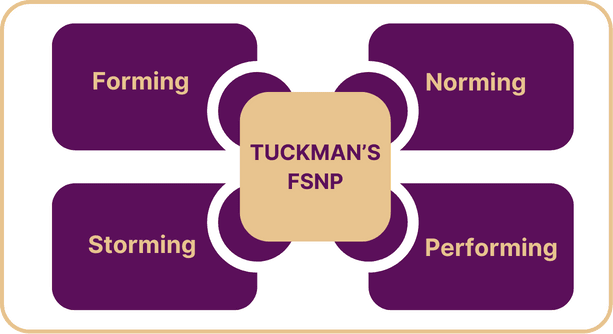Unlock the Secrets to Successful Team Dynamics with Tuckman's FSNP Model
Download our sample Group Dynamic Report today to see Tuckman’s FSNP Model in action within our pioneering tool, Evivve. Experience how game-based learning can enhance communication, boost problem-solving, and strengthen leadership within your team.


Discover the Power of Tuckman's Model
Forming:
Lay the foundation for a cohesive team. Witness how individuals identify roles and cultivate trust.

Storming:
Navigate conflicts and foster resilience. Engage with a stage where diverse opinions ignite creativity and innovation.

Norming:
Establish a rhythm of collaboration. Learn how teams harmonize their processes and align their goals.

Performing:
Reach the pinnacle of teamwork. Equip your team to operate efficiently, where everyone contributes to shared successes.

Join us in redefining teamwork and witness your team thrive like never before.
- Team Development Stages: Understand which phase your team is currently in, whether it's Forming, Storming, Norming, or Performing. This awareness helps tailor interventions to effectively guide the team to the next stage.
- Conflict Resolution: During the Storming phase, conflicts are common. The GDR can provide strategies for conflict resolution, helping team leaders mediate disputes and foster a positive environment.
- Communication Patterns: Analyze and improve communication within the team. Identify any barriers and create more efficient communication channels to ensure everyone is on the same page.
- Role Clarification: Defined roles and responsibilities prevent overlap and confusion. The GDR can help teams clarify roles to enhance productivity, especially during the Norming phase.
- Performance Optimization: For teams in the Performing stage, the GDR can highlight areas for further optimization and scaling of successes.
Who Can Use GDRs?
Leadership & Management
Evaluate team dynamics. Inform strategic decisions.
HR & Talent Development:
Improve team integration. Enhance employee development.
Project Management & Business Development:
Optimize project success. Drive business performance
Download Your Sample Report Today Discover how you can harness the potential of Tuckman's FSNP model for your organization.The Group Dynamic Report (GDR) offers valuable insights into team behavior and collaboration, aligning well with Tuckman's FSNP model phases.
Your favorite brands Evivve
FAQs:
What is a Group Dynamic Report and how does it work?
A Group Dynamic Report (GDR) comprehensively analyzes a team's development and behaviors using models like Tuckman's FSNP. It evaluates team stages such as Forming, Storming, Norming, and Performing and provides insights and recommendations for improving collaboration, resolving conflicts, and enhancing productivity.
Why is understanding team dynamics important?
Understanding team dynamics is crucial for fostering an efficient and harmonious working environment. Knowing which stage of development your team is in helps leaders implement specific strategies to address issues, improve communication, and guide the team through transitions effectively.
How can a GDR benefit my organization?
A GDR can improve team performance by highlighting areas needing improvement, recommending conflict resolution strategies, clarifying roles, and optimizing communication. This leads to more cohesive teams that can achieve organizational goals more effectively.
Who should be involved in the GDR process?
Ideally, the GDR process involves team leaders, members, HR professionals, and sometimes external consultants. Involvement from multiple perspectives ensures a comprehensive understanding of the team dynamics and the formulation of actionable strategies.
How often should we conduct a Group Dynamic analysis?
Conducting a Group Dynamic analysis annually or at critical stages of team projects can be beneficial. It can also be conducted when there is noticeable conflict, a change in team composition, or when aiming to boost performance.